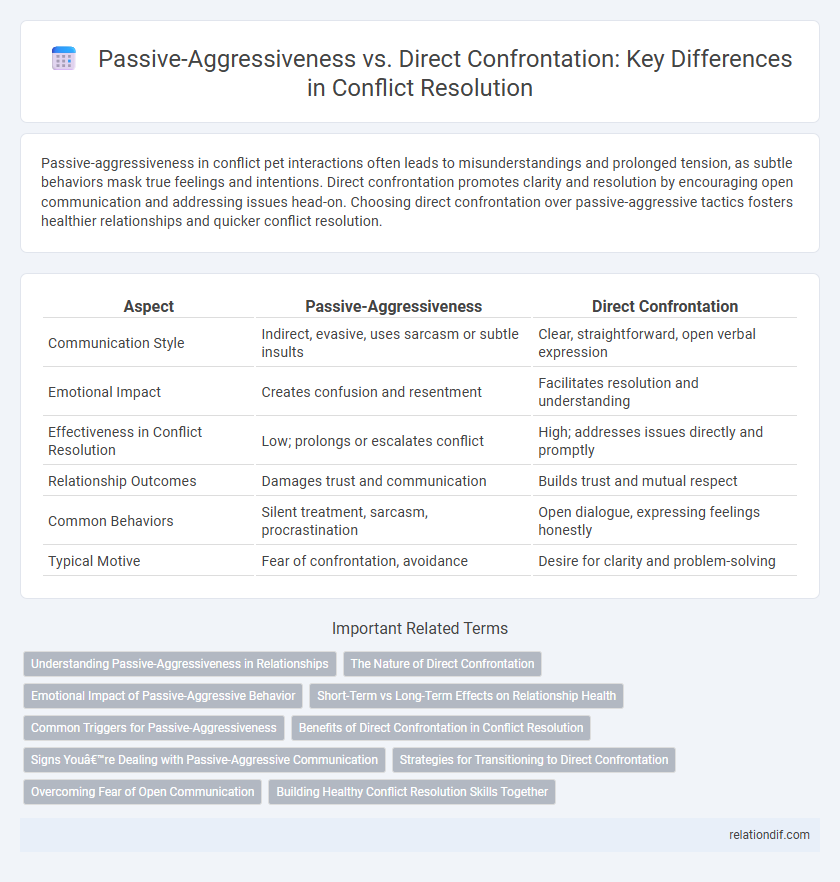Passive-aggressiveness in conflict pet interactions often leads to misunderstandings and prolonged tension, as subtle behaviors mask true feelings and intentions. Direct confrontation promotes clarity and resolution by encouraging open communication and addressing issues head-on. Choosing direct confrontation over passive-aggressive tactics fosters healthier relationships and quicker conflict resolution.
Table of Comparison
| Aspect | Passive-Aggressiveness | Direct Confrontation |
|---|---|---|
| Communication Style | Indirect, evasive, uses sarcasm or subtle insults | Clear, straightforward, open verbal expression |
| Emotional Impact | Creates confusion and resentment | Facilitates resolution and understanding |
| Effectiveness in Conflict Resolution | Low; prolongs or escalates conflict | High; addresses issues directly and promptly |
| Relationship Outcomes | Damages trust and communication | Builds trust and mutual respect |
| Common Behaviors | Silent treatment, sarcasm, procrastination | Open dialogue, expressing feelings honestly |
| Typical Motive | Fear of confrontation, avoidance | Desire for clarity and problem-solving |
Understanding Passive-Aggressiveness in Relationships
Passive-aggressiveness in relationships often manifests through indirect resistance and subtle behaviors like sarcasm, procrastination, or silent treatment, which mask true feelings and avoid direct confrontation. Recognizing these patterns is crucial for addressing underlying emotional conflicts and fostering healthier communication channels. Understanding the dynamics of passive-aggressive behavior helps partners move toward more honest and effective conflict resolution.
The Nature of Direct Confrontation
Direct confrontation involves openly addressing conflicts through clear, honest communication aimed at resolving issues efficiently. It fosters transparency and accountability, reducing misunderstandings by expressing concerns or grievances without ambiguity. This approach often leads to quicker conflict resolution and encourages mutual respect between parties involved.
Emotional Impact of Passive-Aggressive Behavior
Passive-aggressive behavior often causes confusion and frustration, undermining trust and escalating emotional distress within relationships. This indirect expression of anger can lead to increased anxiety and resentment, as the true issues remain unaddressed and communication breaks down. Unlike direct confrontation, which seeks resolution through openness, passive-aggressiveness fosters emotional distance and prolonged conflict.
Short-Term vs Long-Term Effects on Relationship Health
Passive-aggressive behavior often leads to unresolved tensions and erodes trust over time, damaging relationship health in the long term. Direct confrontation, while potentially causing short-term discomfort, fosters clearer communication and allows for quicker resolution of conflicts. Consistently addressing issues openly promotes long-term relationship resilience and mutual understanding.
Common Triggers for Passive-Aggressiveness
Common triggers for passive-aggressiveness include feelings of helplessness, fear of confrontation, and suppressed anger, often resulting from unresolved conflicts or perceived power imbalances. Individuals may avoid direct communication to express dissatisfaction indirectly through sarcasm, procrastination, or subtle sabotage, perpetuating tension. Recognizing these triggers helps in addressing underlying issues and promoting healthier communication strategies.
Benefits of Direct Confrontation in Conflict Resolution
Direct confrontation in conflict resolution promotes clear communication, reducing misunderstandings and fostering mutual respect between parties. It encourages timely problem-solving and prevents the buildup of resentment often caused by passive-aggressive behaviors. This approach enhances emotional honesty and accountability, leading to more effective and lasting resolutions.
Signs You’re Dealing with Passive-Aggressive Communication
Passive-aggressive communication often manifests through indirect resistance, sarcasm, and subtle sabotage rather than open confrontation. Signs include frequent procrastination, backhanded compliments, and silent treatment, which mask true feelings and create confusion. Recognizing these behaviors early helps differentiate them from direct confrontation, fostering more effective conflict resolution.
Strategies for Transitioning to Direct Confrontation
Transitioning from passive-aggressiveness to direct confrontation involves developing clear communication skills and fostering emotional intelligence to express concerns openly and respectfully. Practicing assertiveness training and setting specific boundaries helps individuals move away from indirect behaviors toward transparent dialogue. Implementing conflict resolution frameworks, such as active listening and structured feedback sessions, enhances mutual understanding and builds trust in confrontational settings.
Overcoming Fear of Open Communication
Overcoming fear of open communication requires recognizing passive-aggressiveness as a barrier to resolving conflict effectively. Direct confrontation fosters clarity and mutual understanding by encouraging honest expression of feelings and concerns. Embracing transparent dialogue reduces misunderstandings and promotes healthier relationship dynamics in both personal and professional settings.
Building Healthy Conflict Resolution Skills Together
Passive-aggressiveness manifests through indirect resistance and hidden resentment, undermining trust and escalating misunderstandings in conflict resolution. Direct confrontation encourages open communication and clarity, fostering mutual respect and effective problem-solving. Building healthy conflict resolution skills together involves cultivating emotional awareness, active listening, and cooperative dialogue to transform disputes into opportunities for growth and collaboration.
Passive-aggressiveness vs Direct confrontation Infographic

 relationdif.com
relationdif.com